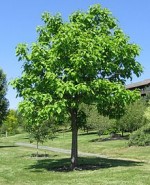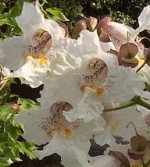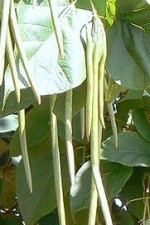 A native of bottomlands and river terraces, northern catalpa has naturalized throughout eastern and central North America. Its bold heart shaped leaves provide textural interest and the large flower heads are a striking addition to the landscape. The long pendulous seed pods are produced in abundance every 2-3 years and inspired the common name “cigar tree” but can be a mess to clean up. Because the leaves are large they are prone to damage by wind, pests, and hail so can further add to the debris problem. The branches are brittle and tend to break but the resulting irregular growth pattern can make the silhouette of the tree more attractive. Northern catalpa is a good specimen or lawn tree where soil conditions are less than ideal and its coarse texture can be appreciated.
A native of bottomlands and river terraces, northern catalpa has naturalized throughout eastern and central North America. Its bold heart shaped leaves provide textural interest and the large flower heads are a striking addition to the landscape. The long pendulous seed pods are produced in abundance every 2-3 years and inspired the common name “cigar tree” but can be a mess to clean up. Because the leaves are large they are prone to damage by wind, pests, and hail so can further add to the debris problem. The branches are brittle and tend to break but the resulting irregular growth pattern can make the silhouette of the tree more attractive. Northern catalpa is a good specimen or lawn tree where soil conditions are less than ideal and its coarse texture can be appreciated.
 Type: Deciduous tree
Type: Deciduous tree
Outstanding Feature: Flowers
Form: Irregular, rounded
Growth Rate: Fast
Bloom: Bell-shaped white flowers with purple and yellow spotting are borne in large showy terminal upright clusters in late spring and are followed by seed pods 8-22” long.
 Foliage: Whorls of large heart shaped kelly green leaves 6-12” long and half as wide
Foliage: Whorls of large heart shaped kelly green leaves 6-12” long and half as wide
Size: 50-75’ H x 35-50’ W
Light: Full sun
Soil: Average to humus rich, moist to dry, slightly alkaline to slightly acidic; tolerates low fertility, some wetness, and drought.
Hardiness: Zones 4-8
Care: Clean up seedpods, branches and leaves.
Pests and Diseases: None of importance except catalpa hornworm that can defoliate the tree in a summer; susceptible to leaf spots, powdery mildew, verticillium wilt, and twig blight.
Propagation: Seed, cuttings; transplants easily
Comments: Can be invasive
